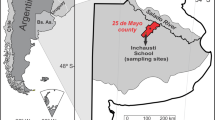Abstract
The submerged vegetation growing in the drainage channels taking effluent from three factories (two processing sugar cane plus one producing chipboard or paper pulp; and one large fertilizer plant) into the River Nile in Upper Egypt, and in the river itself upstream and downstream of the discharge points, was studied during 1994. The main pollutants from the sugar cane factory effluents comprised organic matter, including carbohydrates; from the fertilizer plant ammonia was the principal pollutant. The study investigated the effect of these different pollutants on aquatic plant standing crop and distribution, in relation to physico-chemical characteristics of water and hydrosoil. In the effluent channels, dominated by large growths of sewage fungus, submerged vegetation was absent, although some emergent vegetation survived. In the most polluted river sites, up to 2 km downstream of discharge points, the flora was restricted to Potamogeton pectinatus L. Elsewhere in the river, a more diverse submerged flora was present, including Ceratophyllum demersum L. and Potamogeton crispus L.
Similar content being viewed by others
References
Agami, M., 1984. Effects of water pollution on plant species composition along the Amal River, Israel. Arch. Hydrobiol. 100: 445–454.
Ali, M. M., 1992. Ecological Studies on Freshwater Macrophytes in Regulated Waterbodies in Egypt and UK. Ph.D. Thesis, Faculty of Science at Aswan, Assiut University: 263 pp.
Allen, S. E., H. M. Grimshaw & A. P. Rowland, 1986. Chemical analysis. In Methods in Plant Ecology. P D. Moore & S. B. Chapman (eds), 285–344.
American Public Health Association, 1980. Standard Methods for the Examination of Water and Waste Water. Amer. Publ. Health Assoc., Wash. D.C. 874 pp.
Best, E. P. H., 1979. Growth substances and dormancy in Ceratophyllum demersum L. Physiol. Plant. 45: 339–406.
Caffrey, J., 1985. A scheme for the assessment of water quality using aquatic macrophytes as indicators. J. life Sci. R. Dubl. Soc. 5: 105–111.
Drew, M. C. & J. M. Lynch, 1980. Soil anaerobiosis, microorganisms, and root function. Annu. Rev. Phytopathol. 18: 37–66.
Grime, J. P, 1979. Plant strategies and vegetation processes. John Wiley & Sons Ltd. Publ., Chichester. 222 pp.
Jones, G. & D. R. Cullimore, 1973. Influences of macro-nutrients on the relative growth of water-plants in the Qu'Apelle lakes, Canada. Envir. Pollut. 4: 283–290.
Kadono, Y., 1982. Occurrence of aquatic macrophytes in relation to pH, alkalinity, Ca++, Cl− and conductivity. Jap. J. Ecol. 32: 39–44.
Kautsky, L., 1987. Life-cycles of three populations of Potamogeton pectinatus L. at different degrees of wave exposure in the Askö area, Northern Baltic proper. Aquat. Bot. 27: 177–186.
Kautsky, L., 1988. Life strategies of aquatic soft bottom macrophytes. Oikos. 53: 126–135.
Murphy, K. J., B. Rørslett & I. Springuel, 1990. Strategy analysis of submerged aquatic lake macrophyte communities: an international example. Aquat. Bot. 36: 303–323.
Raven, P H., L. R. Berg & G. B. Johnson, 1993. Environment. Saunders College Publ. 569 pp.
Seager, J., F. Jones & G. Rutt, 1992. Assessment of control of farm pollution. Journal if the I.W.E.M., 6: 48–54.
Ter Braak, C. J. F., 1987. CANOCO — a FORTRAN Program for Canonical Communitiy Ordination By Parial Detrended Canonical Correspondence Analysis, Principal Components Analysis and Redundancy Analysis (Version 3.1). Agriculture Mathematics Group, Wageningen.
Van Wijk, R. J., 1986. Life cycle characteristics of Potamogeton pectinatus L. in relation to control. Proceedings EWRS/AAB 7th Symposium on Aquatic Weed 375–380.
Author information
Authors and Affiliations
Rights and permissions
About this article
Cite this article
Ali, M.M., Soltan, M.E. The impact of three industrial effluents on submerged aquatic plants in the River Nile, Egypt. Hydrobiologia 340, 77–83 (1996). https://doi.org/10.1007/BF00012737
Issue Date:
DOI: https://doi.org/10.1007/BF00012737




